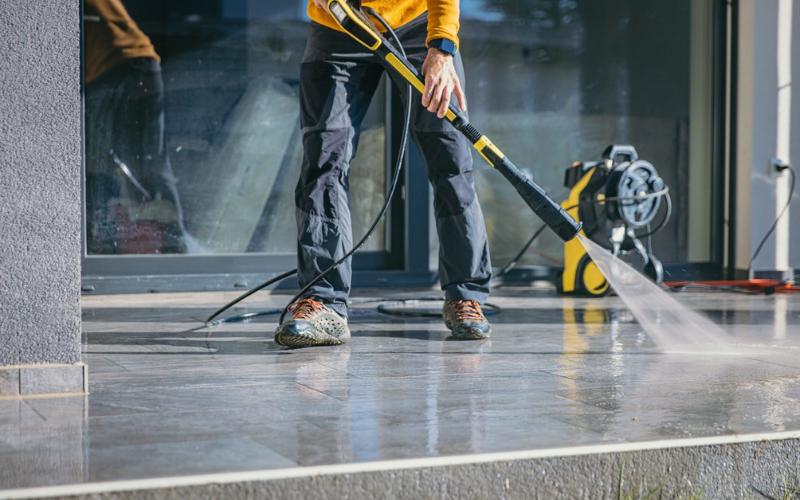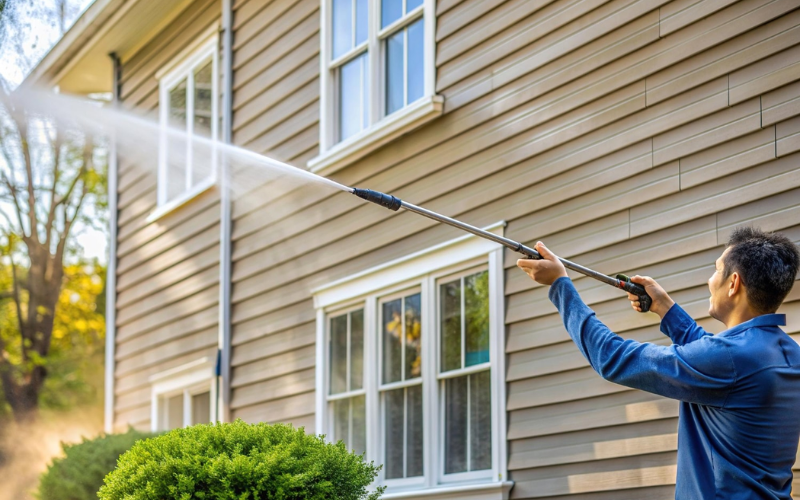
There’s something deeply satisfying about seeing years of buildup wash away from your home’s exterior. The layers of dirt, pollen, mold, and dust can dull your property’s charm over time, no matter how beautiful its design is. Booking your first house washing service often feels like crossing a threshold—from simply living with the grime to actively reclaiming your home’s brightness and curb appeal.
But if you’ve never had it done before, it’s fair to wonder what really happens during that appointment. Is it all just high-pressure spraying? Do you have to move things? Will the technicians go around the windows or directly clean them too? This guide unpacks everything in clear, honest detail so that when your first cleaning day arrives, you won’t just be ready—you’ll feel confident and even a bit excited.
Key Takeaways
-
A professional house washing service can revitalize your home’s look while protecting its structure from grime and mildew.
-
The process includes inspection, prep work, cleaning, and post-wash checks.
-
Knowing what to expect helps you feel more confident and make the most of your first appointment.
-
Preparation, communication, and understanding cleaning methods go a long way.
-
The results are often transformative, revealing a home that looks newer, fresher, and better preserved.
Understanding Why House Washing Matters
Let’s start with why this service holds real value. Your home’s exterior faces constant exposure to elements—sun, rain, wind, pollutants, algae, and even bird droppings. Over time, all of that takes a toll. What starts as a film of dirt can turn into mold or mildew colonies that slowly eat into paint or siding.
A house washing service goes beyond a nice appearance. It protects the materials underneath, adds life to paintwork, and helps prevent future maintenance expenses. Some homeowners even schedule a wash before repainting or before listing their home for sale—it’s that effective visually and structurally.
How Professionals Assess Your Home Before Washing
Every reputable crew begins with an inspection. They’ll walk around the property, evaluating surfaces, noting materials, and identifying problem spots. Vinyl siding, stucco, wood, and brick each need different pressure levels and solutions. For example, wood might require a gentler soft wash process, while vinyl can typically handle a bit more force.
You can expect them to check for:
-
Mold or algae growth
-
Cracked or loose siding panels
-
Chipping paint areas
-
Rust stains
-
Hard-to-reach corners
-
Any electrical components, lighting, or outlets that need protection
This walkthrough is also your time to ask questions—things like how long the wash will take or how they handle landscaping around the area. The best teams explain their plan clearly and recommend minor prep steps you can take to make the job smoother.
Prepping Before the Team Arrives
While the crew will handle most of the setup, there are a few homeowner prep steps that make a big difference:
-
Move outdoor furniture, decorations, or fragile items away from walls.
-
Close all windows tightly and check that screens are secure.
-
Cover outdoor outlets or cameras if they’re not waterproof.
-
Trim any overgrown bushes or branches touching the house.
-
Move cars out of the driveway if washing equipment will block them.
Some homeowners even snap “before” pictures to compare results—something you’ll likely enjoy seeing afterward.
The Setup: Ladders, Hoses, and Safety
Once the team is ready, you may see equipment like ladders, pressure hoses, water tanks, or chemical dispensers. It might look like a lot, but everything has a role. Their machines often run from a water connection, either directly from your hose bib or from their tanks.
You’ll probably notice them marking delicate zones—near vents, meters, or outdoor electric units—with protective materials. At this stage, everything feels procedural, and you’ll realize just how much precision goes into what seems, from outside, like “just spraying water.”
The Main Cleaning Process
Once setup is complete, the real transformation begins. The cleaning typically follows a sequence that covers walls, siding, eaves, gutters, and sometimes even driveways or steps.
Soft Washing vs. Pressure Washing
For many residential jobs, soft washing—using low-pressure water with cleansing agents—is preferred. It safely removes mildew, algae, and grime without eroding paint or sealants. Pressure washing, on the other hand, uses more force and is ideal for tougher surfaces like concrete, brick, or stone.
Watching the Transformation
If you’re home during the service, you’ll start seeing small miracles unfold in real time—dingy gray siding returning to a crisp light tone, green streaks disappearing from under eaves, and the house beginning to look more alive. It’s not uncommon for homeowners to pause with a bit of disbelief as clean patterns emerge against areas yet to be touched.
Post-Wash Rinsing and Cleanup
Once the active cleaning wraps up, technicians will typically rinse down every surface again, sometimes using clearer water or a different nozzle attachment to remove soap residue. They’ll then gather hoses, double-check exterior fittings, and do a final walkthrough with you.
This is when they’ll point out before-and-after contrasts or inform you about stubborn stains that may have lightened but not fully lifted—like embedded iron deposits or older oxidized areas on siding. You can discuss whether those might benefit from a future touch-up or specialty treatment.
What You’ll Notice Immediately After
Right after the service, what stands out first is the brightness. Paint looks more defined. Trim pops again. A faint fresh scent, almost rainlike, hangs in the air. You might not have realized how dulled your surfaces had become until they suddenly shimmer clean again.
If your home has lighter-colored walls, this change feels especially striking. Even brick or darker tones carry a sharpness and depth. It’s common to see driveways and front steps looking noticeably improved, too, if those areas were part of the package.
Common Concerns First-Time Homeowners Have
A few worries come up often before the first service:
-
Will the pressure damage paint or siding? Professional washers adjust water levels and nozzles carefully based on your surface type.
-
Will it harm plants? As long as they’re pre-rinsed and shielded, your landscaping should be perfectly safe.
-
Do you need to be home? Not necessarily, but being present helps you stay informed and ask questions.
-
Will it leave streaks or lines? Skilled technicians maintain consistent spray distance to avoid uneven patterns.
-
What about water usage? The average house washing doesn’t use significantly more water than a few long showers—it’s controlled and deliberate.
The Environmental Aspect

Modern home washing has evolved past the harsh sprays and chemical-heavy detergents of decades ago. Today, biodegradable and eco-friendly cleaners dominate the industry standard. Many services reclaim water runoff or redirect it away from storm drains, supporting sustainability goals that more homeowners value.
Timing and Frequency
Most homes benefit from a full wash once a year, though this depends on local climate, tree coverage, and dust exposure. Coastal properties may require two cleanings a year due to salt buildup, while shaded homes might need more frequent mildew control.
Unexpected Benefits of a Clean Exterior
Beyond the visual reward, many homeowners find emotional uplift in seeing their space renewed. A cleaner exterior encourages outdoor activity—sitting on the porch, gardening, or simply admiring the property again. It can even subtly raise home pride and reduce stress associated with deferred maintenance.
Aftercare and Maintenance Tips
Once your home’s sparkle is restored, you’ll want to keep it that way. Here’s how to stretch the freshness:
-
Rinse low areas like porches or walkways after heavy pollen or storms.
-
Keep gutters clear so dirty runoff doesn’t streak walls.
-
Watch shaded sections for regrowth of algae and treat them early.
-
Schedule light spot cleanings if birds or sap coat specific areas.
-
Ask your cleaner about gentle DIY rinses using diluted vinegar or mild soap between professional visits.
Routine attention helps your next appointment work faster and last longer.
Choosing the Right Provider
Not all cleaning services operate the same way, and with your first experience, it’s worth knowing what separates a decent wash from a truly satisfying one. Look for providers with clear safety processes, insured crews, and transparent explanations of their cleaning solutions. Read local reviews, get quotes, and trust technicians who listen more than they pitch.
When researching, you might type something like house washing service near me to explore local specialists and see their customer ratings. Proximity allows for better communication and often faster scheduling.
What Happens If Something Goes Wrong?
While rare, sometimes issues arise—a loose shutter, a clogged drain from debris, or stains that return due to deep mold spores. If so, report it immediately. Reputable teams usually offer a satisfaction policy, inspecting or redoing affected areas. Small mishaps can happen with any hands-on job, but professional accountability distinguishes a serious outfit from a careless one.
The Emotional Side of That First Wash
A surprising thing happens for many homeowners once the wash is done: the experience shifts from a practical service to an emotional refresh. You might walk outside at sunset, see your siding gleam, and feel an oddly personal satisfaction. It’s more than cleanliness; it’s reclaiming your home’s outer expression, the face it shows to the world.
People talk about interior makeovers constantly, but an exterior wash can be equally transformative—sometimes even more so because it restores your view before others’ eyes. The way the light hits your walls, the contrast around windows, the brightened porch rail—it all feels subtly uplifting.
The Cost Perspective—Value Beyond Money
Prices vary depending on house size, surfaces, and accessibility, but when you break it down, it’s a cost-effective service. Instead of repainting or replacing siding, washing often extends life spans by years. Plus, you’re investing in a healthier environment, eliminating spores and allergens that may affect air quality.
Small Details That Go Unnoticed but Matter
As water jets sweep across your home, little details—kickboards, soffits, door frames—receive care too. These spots rarely get hand-scrubbed in regular upkeep but collect grime relentlessly. Their renewed brightness enhances the entire home’s appearance more than you might predict.
Final Walkthrough: Wrapping Up the Experience

Before leaving, the crew will likely invite you to inspect results together. Walk around, note shine levels, verify no missed areas, and ask for maintenance do’s and don’ts. They may offer estimates for recurring services if you’d like to set up a routine schedule, but you’re under no obligation.
When the truck pulls away, your driveway might still be wet, yet your house already looks dramatically revived. The hardest part now? Waiting for everything to dry completely so you can take those “after” photos.
Conclusion
Your first house washing service marks more than a cleaning—it’s a reintroduction to your home. You’ll rediscover its colors, appreciate its form, and see it as others do: cared-for, alive, and welcoming.
Preparation makes your experience smoother, understanding the process sets expectations, and choosing the right team ensures satisfaction. With yearly upkeep and mindfulness, your exterior can keep that just-washed look far longer than expected.
Frequently Asked Questions
1. How long does a full house washing take?
Usually between two to four hours for an average-sized home, depending on dirt buildup and weather conditions.
2. Is soft washing safe for painted surfaces?
Yes. Soft washing uses low pressure and gentle biodegradable cleaners designed to safeguard paint, siding, and trim.
3. Can house washing remove rust or deep stains?
Some rust or oxidation marks may fade but not disappear entirely. Specialized treatment might be required afterward.
4. Should I be present during the service?
It’s recommended but not mandatory. Being onsite helps you discuss concerns or inspect results immediately after.
5. What’s the best season to schedule a wash?
Spring and fall are ideal since they balance weather conditions and prepare your home for upcoming seasonal changes.





